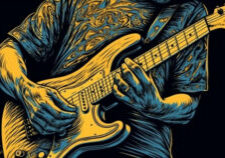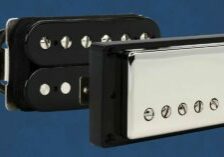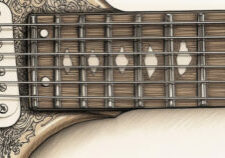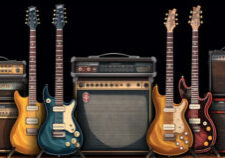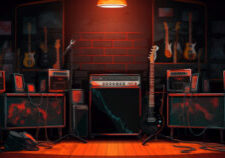The Gibson Les Paul is one of the most iconic electric guitars of all time. It has been a staple of rock and roll for decades, and its influence on electric guitar design is undeniable. The Les Paul was first introduced in 1952, and since then it has become one of the most popular and recognizable guitars in the world. Its unique design, sound, and playability have made it a favorite of guitarists from all genres. In this article, we will explore the history of the Gibson Les Paul and its impact on electric guitar design.
The Origins of the Gibson Les Paul and Its Impact on Electric Guitar Design
The Gibson Les Paul has been used by some of the most influential guitarists in history, including Jimmy Page, Slash, and Eric Clapton. The Les Paul has been a staple of rock and roll for decades, and its influence on electric guitar design is undeniable.
The Les Paul was first introduced in 1952 by Gibson, a company that had been making guitars since the late 1800s. The original design was based on a prototype created by the legendary guitarist and inventor Les Paul. Paul had been experimenting with electric guitars since the 1930s, and his design featured a solid body, two pickups, and a unique combination of tone and volume controls.
The Les Paul quickly became a favorite among guitarists, and it was soon adopted by some of the most influential players of the time. Its combination of power and sustain made it ideal for rock and roll, and it was used by many of the genre’s pioneers, including Chuck Berry and Keith Richards.
The Les Paul’s influence on electric guitar design is still felt today. Its combination of features has become the standard for many electric guitars, and its design has been copied and modified by countless manufacturers. The Les Paul’s influence can be seen in the designs of popular guitars such as the Fender Stratocaster and the Gibson SG.
The Les Paul has also had a major impact on the sound of electric guitars. Its combination of pickups and tone controls has allowed guitarists to create a wide range of sounds, from clean and bright to heavy and distorted. This versatility has made the Les Paul a favorite among many different genres of music, from blues to metal.
The Evolution of the Gibson Les Paul and Its Influence on Music
The Les Paul has evolved over the years, and its evolution has been integral to its success. The original Les Paul was designed by Ted McCarty, who wanted to create a guitar that was both powerful and versatile. This featured two single-coil pickups, a solid mahogany body, and a maple top. This combination of features gave the guitar a unique sound that was unlike any other guitar at the time.
The Les Paul was the first solid-body electric guitar to be mass-produced, and it revolutionized the way electric guitars were designed and played. The guitar featured a unique and innovative set of controls, including a three-way toggle switch, two volume knobs, and two tone knobs. This allowed players to shape their sound in ways that had never been possible before. They could explore new sounds and techniques, which have become staples of modern electric guitar playing.
The guitar produced a thick, warm tone that has been heard on countless classic rock recordings, from Led Zeppelin’s “Stairway to Heaven” to the Rolling Stones’ “Satisfaction.” Its versatility has allowed it to be used in a variety of genres, from jazz to metal.
The Gibson Les Paul: Evolution in the Early Days
This timeline looks at the history of the Gibson Les Paul how it changed from the 1950s to 1980s. a
1952: The Gibson Les Paul is introduced. The Les Paul was designed by Gibson president Ted McCarty and legendary guitarist Les Paul. It featured a solid mahogany body, two single-coil pickups, and a unique trapeze tailpiece. The Les Paul quickly became a favorite among jazz and blues musicians, and its popularity soon spread to rock and roll.
1958: The Gibson Les Paul Standard is released. This version of the Les Paul featured two humbucking pickups, a Tune-o-matic bridge, and a stopbar tailpiece. This combination of features gave the Les Paul a unique sound that was perfect for rock and roll.
1960s: Gibson introduced the Les Paul Deluxe, which featured two humbucking pickups and a thinner body. This version of the guitar was popular with blues and rock guitarists.
1970s: The Gibson Les Paul is adopted by hard rock and heavy metal bands. Its thick, powerful sound is perfect for the heavier music of the era, and it quickly becomes the guitar of choice for many of the most influential guitarists of the era, including Eddie Van Halen and Randy Rhoads.
1980s: The Gibson Les Paul is adopted by a new generation of guitarists. Its warm and powerful sound is perfect for the heavier music of the era, and it quickly becomes the guitar of choice for many of the most influential guitarists of the era, such as Slash from Guns N’ Roses.
The Les Paul Continues Evolving in the 1990s & 2000s
One of the first changes that Gibson made was to the Les Paul’s construction. In the 1990s, Gibson started to experiment with different woods and finishes, and they introduced a range of new models with different features. They also started using computer-controlled machinery to improve the accuracy and consistency of their guitars’ construction.
Another significant change that occurred in the 1990s was the introduction of the Les Paul Studio model. This guitar was aimed at players who wanted a Les Paul but couldn’t afford the high price tag of the standard model. The Studio had a simpler design with fewer frills, but it still had the same classic Les Paul tone.
It has undergone several changes throughout its history, and one of the most significant periods of evolution occurred in the 1990s and beyond. In this article, we’ll take a closer look at how the Gibson Les Paul changed from the 1990s to today.
In the early 1990s, Gibson was experiencing financial difficulties, which resulted in a change in ownership. In 1993, the company was bought by a group of investors led by Henry Juszkiewicz, who aimed to revitalize the brand and bring it back to its former glory. This change in ownership marked the beginning of a new era for Gibson and the Les Paul.
One of the first changes that Gibson made was to the Les Paul’s construction. In the 1990s, Gibson started to experiment with different woods and finishes, and they introduced a range of new models with different features. They also started using computer-controlled machinery to improve the accuracy and consistency of their guitars’ construction.
Another significant change that occurred in the 1990s was the introduction of the Les Paul Studio model. This guitar was aimed at players who wanted a Les Paul but couldn’t afford the high price tag of the standard model. The Studio had a simpler design with fewer frills, but it still had the same classic Les Paul tone.
In the 2000s, Gibson continued to innovate and make changes to the Les Paul. They introduced a new line of guitars called the “Historic” series, which were designed to replicate the original Les Pauls from the 1950s and 1960s. These guitars had more accurate specifications and were built using traditional methods.
Another significant change that occurred in the 2000s was the introduction of the Les Paul Robot. This guitar featured a system of sensors and motors that could automatically tune the guitar to different presets. This innovation was controversial, with some players criticizing it as a gimmick and others praising it for its convenience.
The Gibson Les Paul in Modern Times
One of the most significant changes in recent years has been the introduction of the Gibson Custom Shop. This shop specializes in creating high-end, custom Les Paul guitars that are made to order. These guitars are built using the finest materials and are designed to replicate the original Les Pauls from the 1950s and 1960s. They have become a favorite among collectors and professional musicians.
Another change in recent years has been the introduction of the Les Paul Modern. This guitar features modern design elements, such as a contoured body, a slim-taper neck profile, and coil-tapped humbucking pickups. It also has a variety of finishes, including the popular “Faded Pelham Blue” and “Graphite” finishes.
Gibson has also experimented with different electronics in recent years. The Les Paul Standard 2019 features the new “Modern” weight relief, which reduces the guitar’s weight without sacrificing tone. It also features the new Burstbucker pickups, which are designed to replicate the tone of vintage PAF pickups. The Les Paul Classic 2019 features a new pickup configuration, with a P-90 pickup in the neck position and a Burstbucker in the bridge position.
In terms of finishes, Gibson has introduced several new options in recent years. The Les Paul Classic 2019 is available in a “Honeyburst” finish, while the Les Paul Traditional 2019 comes in a “Heritage Cherry Sunburst” finish. Gibson has also introduced several new finishes for their Les Paul Standard line, including “Cobra Burst,” “Blueberry Burst,” and “Seafoam Green.”
Finally, Gibson has continued to make improvements to their construction methods. In 2019, they introduced a new technique called “Ultra-Modern Weight Relief,” which reduces the guitar’s weight even further without affecting its tone. They have also introduced a new neck joint called the “Modern Contoured Heel,” which provides better access to the upper frets.
The Impact of a Timeless Guitar
The Gibson Les Paul has had a profound impact on the design of electric guitars. Its combination of innovative features, classic design, and superior craftsmanship has made it one of the most iconic instruments in the history of music. Its influence can be seen in the designs of countless electric guitars. That’s why you can walk into a jazz club and watch someone playing a Les Paul. Then go across town into heavy metal concert and find the guitarist playing the exact same guitar (but probably has hotter pickups). The Gibson Les Paul will continue to inspire generations of guitarists for years to come.

